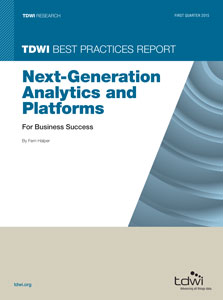
Best Practices Report | Next-Generation Analytics and Platforms
December 18, 2014
User organizations are pushing the envelope in terms of analytics and the platforms to support
analysis. These organizations realize that to be competitive, they must be predictive and proactive.
However, although the phrase “next-generation platforms and analytics” can evoke images of
machine learning, big data, Hadoop, and the Internet of things, most organizations are somewhere
in between the technology vision and today’s reality of BI and dashboards. Next-generation
platforms and analytics often mean simply pushing past reports and dashboards to more advanced
forms of analytics, such as predictive analytics. Next-generation analytics might move your
organization from visualization to big data visualization; from slicing and dicing data to predictive
analytics; or to using more than just structured data for analysis. The market is on the cusp of
moving forward.
Although the majority of our survey respondents use some kind of analytics software against their
data warehouse or a commercial analytics package on their server, they show great interest in moving
ahead with more advanced forms of analytics and the infrastructure to support it. Technologies such
as predictive analytics, geospatial analytics, text analytics, and in-stream analysis are all poised to
double in use over the next three years if users stick to their plans. Additionally, more than 50% of
our survey respondents are already using an analytics platform or appliance. They are looking at
other platforms, too, such as in-memory databases, analytics, and in-memory computing. They are
exploring (and using) the cloud. There are challenges, too: More than half of respondents cite skills
as their top challenge, followed by the closely related challenge of understanding the technology.
For companies that are making use of more advanced analytics, the results are rewarding. These
enterprises are monitoring and analyzing their operations and predicting and acting on behaviors
of interest. They are measuring top- and bottom-line impacts. In fact, about a quarter of the survey
respondents are already measuring this impact. These respondents are more likely to use advanced
analytics and disparate data types. They are building a coordinated data ecosystem. There is no silver
bullet to get there, but these companies are making it happen.
This TDWI Best Practices Report focuses on how organizations can and do use next-generation
analytics. It provides in-depth analysis of current strategies and future trends for next-generation
analytics across both organizational and technical dimensions, including organizational culture,
infrastructure, data, and processes. It examines both the analytics and infrastructure necessary for
next-generation analytics. This report offers recommendations and best practices for implementing
analytics in an organization.